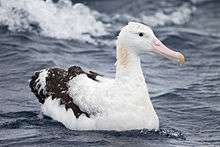Prince Edward Islands
The Prince Edward Islands are two small islands in the subantarctic Indian Ocean that are part of South Africa. The islands are named Marion Island (named after Marc-Joseph Marion du Fresne) and Prince Edward Island (named after Prince Edward, Duke of Kent and Strathearn).
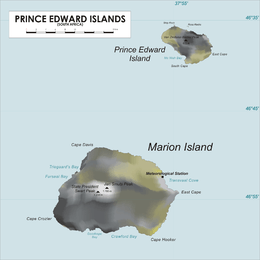 Map of Prince Edward Islands | |
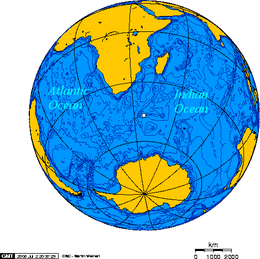 Orthographic projection centred on the Prince Edward Islands | |
| Geography | |
|---|---|
| Location | Indian Ocean |
| Coordinates | 46°53′19″S 37°44′08″E |
| Area | 335 km2 (129 sq mi) |
| Highest elevation | 1,242 m (4,075 ft) |
| Highest point | Mascarin Peak |
| Administration | |
| Demographics | |
| Population | 0 (Uninhabited – Permanent) 50 (Research Staff – Non-Permanent) |
| Designations | |
|---|---|
| Designated | 24 January 1997 |
| Reference no. | 1688[1] |
The islands in the group have been declared Special Nature Reserves under the South African Environmental Management: Protected Areas Act, No. 57 of 2003, and activities on the islands are therefore restricted to research and conservation management.[2][3] Further protection was granted when the area was declared a marine protected area in 2013.[4][5] The only human inhabitants of the islands are the staff of a meteorological and biological research station run by the South African National Antarctic Programme on Marion Island.
History

The islands were discovered on 4 March 1663 by Barent Barentszoon Lam of the Dutch East India Company ship Maerseveen and were named Dina (Prince Edward) and Maerseveen (Marion),[6] but the islands were erroneously recorded to be at 41° South, and neither were found again by subsequent Dutch sailors.[7][8] In January 1772, the French frigate Le Mascarin, captained by Marc-Joseph Marion du Fresne, visited the islands and spent five days trying to land, thinking they had found Antarctica (then not yet proven to exist).[9] Marion named the islands Terre de l'Espérance (Marion) and Ile de la Caverne (Pr. Edward).[7] After failing to land, Le Mascarin continued eastward, discovering the Crozet Islands and landing at New Zealand, where Marion du Fresne and some of his crew were killed and eaten by Māori natives. Julien Crozet, navigator and second in command of Le Mascarin, survived the disaster, and happened to meet James Cook at Cape Town in 1776, at the onset of Cook's third voyage.[10] Crozet shared the charts of his ill-fated expedition, and as Cook sailed from Cape Town, he passed the islands on 13 December, but was unable to attempt a landing due to bad weather.[9] Cook named the islands after Prince Edward, the fourth son of King George III; and though he is also often credited with naming the larger island Marion, after Captain Marion, this name was adopted by sealers and whalers who later hunted the area, to distinguish the two islands.[11]
The first recorded landing on the islands was in 1799 by a group of French seal hunters of the Sally.[11] Another landing in late 1803 by a group of seal hunters led by American captain Henry Fanning of the Catharine found signs of earlier human occupation.[12] The islands were frequented by sealers until about 1810, when the local fur seal populations had been nearly eradicated.[11] The first scientific expedition to the islands was led by James Clark Ross, who visited in 1840 during his exploration of the Antarctic, but was unable to land.[11] Ross sailed along the islands on 21 April 1840. He made observations on vast numbers of penguins ("groups of many thousands each"), and other kinds of sea-birds. He also saw fur seals, which he supposed to be of the species Arctocephalus falklandicus.[13] The islands were finally surveyed during the Challenger Expedition, led by Captain George Nares, in 1873.[14]
The sealing era lasted from 1799 to 1913. During that period visits by 103 vessel are recorded, seven of which ended in shipwreck.[15] Sealing relics include iron trypots, the ruins of huts and inscriptions. The occasional modern sealing vessel visited from Cape Town, South Africa, in the 1920s.
The islands have been the location of other shipwrecks. In June 1849 the brig Richard Dart, with a troop of Royal Engineers under Lt. James Liddell, was wrecked on Prince Edward island; only 10 of the 63 on board survived to be rescued by elephant seal hunters from Cape Town.[16] In 1908 the Norwegian vessel Solglimt was shipwrecked on Marion Island, and survivors established a short-lived village at the north coast, before being rescued.[12][17][18] The wreck of the Solglimt is the best-known in the islands, and is accessible to divers.[12]
In 2003, the South African government declared the Prince Edward Islands a Special Nature Reserve, and in 2013 declared 180,000 km2 (69,000 sq mi) of ocean waters around the islands a Marine Protection Area, thus creating one of the world's largest environmental protection areas.[5]
Marion Research Station
In 1908 the British government assumed ownership of the islands. In late 1947 and early 1948, South Africa, with Britain's agreement, annexed the islands and installed the meteorological station on Transvaal Cove on the north-east coast of Marion Island.[7] The research station was soon enlarged and today studies regional meteorology and the biology of the islands, in particular the birds (penguins, petrels, albatrosses, gulls) and seals.
A new research base was built from 2001 to 2011 to replace older buildings on the site.[19] The access to the station is either by boat or helicopter.[20] A helipad and storage hangar is located behind the main base structure.[19][21]
In April 2017, the South African National Antarctic Programme launched a new experiment on Marion Island called Probing Radio Intensity at high-Z from Marion (PRIZM), searching for signatures of the hydrogen line in the early universe.[22]
Geography and geology
The island group is about 955 nmi (1,769 km; 1,099 mi) south-east of Port Elizabeth in mainland South Africa. At 46 degrees latitude, the distance to the equator is only slightly longer than to the South Pole. Marion Island (46°54′45″S 37°44′37″E), the larger of the two, is 25.03 km (15.55 mi) long and 16.65 km (10.35 mi) wide with an area of 290 km2 (112 sq mi) and a coastline of some 72 km (45 mi), most of which is high cliffs. The highest point on Marion Island is Mascarin Peak (formerly State President Swart Peak), reaching 1,242 m (4,075 ft) above sea level.[23] The topography of Marion Island includes many hillocks and small lakes, and boggy lowland terrain with little vegetation.[24]
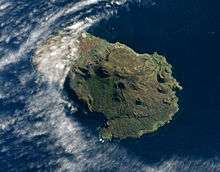
Prince Edward Island (46°38′39″S 37°56′36″E) is much smaller—only about 45 km2 (17 sq mi), 10.23 km (6.36 mi) long and 6.57 km (4.08 mi) wide—and lies some 12 nmi (22.2 km; 13.8 mi) to the north-east of Marion Island. The terrain is generally rocky, with high cliffs (490 m (1,608 ft)) on its south western side.[24] At the van Zinderen Bakker Peak north-west of the center, it reaches a height of 672 metres (2,205 ft).[25]
There are a few offshore rocks along the northern coast of Prince Edward Island, like Ship Rock 100 m (328 ft) north of northernmost point, and Ross Rocks 500 m (1,640 ft) from the shore. Boot Rock is about 500 metres (1,640 ft) off the northern coast of Marion Island.
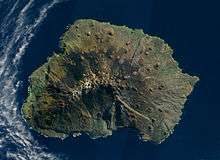
Both islands are of volcanic origin.[24] Marion Island is one of the peaks of a large underwater shield volcano that rises some 5,000 metres (16,404 ft) from the sea floor to the top of Mascarin Peak. The volcano is active, with eruptions having occurred between 1980 and 2004.[23]
Climate
Despite being located inside the south temperate zone at 46 degrees latitude, the islands have a tundra climate. They lie directly in the path of eastward-moving depressions all year round and this gives them an unusually cool and windy climate. Strong regional winds, known as the roaring forties, blow almost every day of the year, and the prevailing wind direction is north-westerly.[24] Annual rainfall averages from 2,400 mm (94.5 in) up to over 3,000 mm (118.1 in) on Mascarin Peak. In spite of its very chilly climate it is located closer to the equator than mild northern hemisphere climates such as Paris and Seattle and only one degree farther south than fellow southern hemisphere climates such as Comodoro Rivadavia in Argentina and Alexandra in New Zealand. Many climates on lower latitudes in the opposite hemisphere have far colder winters than Prince Edward Islands due to their maritime moderation, even though temperatures in summer are way short of normal maritime climates.
It rains on average about 320 days a year (about 28 days a month) and the islands are among the cloudiest places in the world; about 1300 hours a year of sunshine occurs on the sheltered eastern side of Marion Island but only around 800 hours occur away from the coast on the wet western sides of Marion and Prince Edward Islands.
Summer and winter have fairly similar climates with cold winds and threat of snow or frost at any time of the year. However, the mean temperature in February (midsummer) is 7.7 °C (45.9 °F) and in August (midwinter) it is 3.9 °C (39.0 °F).[26][27]
| Climate data for Marion Island (1961–1990, extremes 1949–present) | |||||||||||||
|---|---|---|---|---|---|---|---|---|---|---|---|---|---|
| Month | Jan | Feb | Mar | Apr | May | Jun | Jul | Aug | Sep | Oct | Nov | Dec | Year |
| Record high °C (°F) | 25.6 (78.1) |
22.9 (73.2) |
22.2 (72.0) |
19.3 (66.7) |
18.4 (65.1) |
18.2 (64.8) |
18.6 (65.5) |
16.5 (61.7) |
17.0 (62.6) |
17.7 (63.9) |
19.2 (66.6) |
21.9 (71.4) |
25.6 (78.1) |
| Average high °C (°F) | 10.6 (51.1) |
10.9 (51.6) |
10.6 (51.1) |
9.2 (48.6) |
7.9 (46.2) |
7.3 (45.1) |
6.6 (43.9) |
6.3 (43.3) |
6.6 (43.9) |
7.7 (45.9) |
8.8 (47.8) |
9.8 (49.6) |
8.5 (47.3) |
| Daily mean °C (°F) | 7.2 (45.0) |
7.7 (45.9) |
7.4 (45.3) |
6.2 (43.2) |
5.1 (41.2) |
4.7 (40.5) |
4.1 (39.4) |
3.7 (38.7) |
3.8 (38.8) |
4.5 (40.1) |
5.3 (41.5) |
6.3 (43.3) |
5.5 (41.9) |
| Average low °C (°F) | 4.8 (40.6) |
5.3 (41.5) |
5.0 (41.0) |
3.8 (38.8) |
2.8 (37.0) |
2.2 (36.0) |
1.7 (35.1) |
1.2 (34.2) |
1.4 (34.5) |
2.0 (35.6) |
2.8 (37.0) |
3.8 (38.8) |
3.1 (37.6) |
| Record low °C (°F) | −1.5 (29.3) |
−1.4 (29.5) |
−2.5 (27.5) |
−2.2 (28.0) |
−3.0 (26.6) |
−6.0 (21.2) |
−6.0 (21.2) |
−5.5 (22.1) |
−6.9 (19.6) |
−4.7 (23.5) |
−3.9 (25.0) |
−1.5 (29.3) |
−6.9 (19.6) |
| Average precipitation mm (inches) | 219 (8.6) |
195 (7.7) |
216 (8.5) |
219 (8.6) |
232 (9.1) |
204 (8.0) |
194 (7.6) |
187 (7.4) |
183 (7.2) |
170 (6.7) |
170 (6.7) |
203 (8.0) |
2,399 (94.4) |
| Average precipitation days (≥ 1.0 mm) | 21 | 18 | 19 | 20 | 22 | 23 | 23 | 22 | 21 | 19 | 19 | 20 | 247 |
| Average relative humidity (%) | 83 | 84 | 84 | 84 | 85 | 86 | 85 | 84 | 83 | 82 | 82 | 83 | 84 |
| Mean monthly sunshine hours | 160.4 | 134.7 | 114.2 | 90.8 | 82.1 | 57.5 | 65.9 | 91.7 | 103.9 | 137.7 | 159.1 | 159.9 | 1,357.9 |
| Source 1: NOAA[28] | |||||||||||||
| Source 2: Meteo Climat (record highs and lows)[29] | |||||||||||||
Flora and fauna
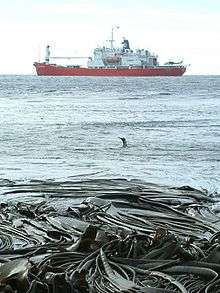
The islands are part of the Southern Indian Ocean Islands tundra ecoregion that includes a small number of subantarctic islands. Because of the paucity of land masses in the Southern Ocean, the islands host a wide variety of species and are critical to conservation.[5] In the cold subantarctic climate, plants are mainly limited to grasses, mosses, and kelp, while lichens are the most visible fungi. The main indigenous animals are insects along with large populations of seabirds, seals[30] and penguins.[31] At least twenty-nine different species of birds are thought to breed on the islands, and it is estimated the islands support upwards of 5 million breeding seabirds, and 8 million seabirds total.[5] Five species of albatross (of which all are either threatened or endangered) are known to breed on the islands, including the wandering albatross, dark-mantled, light-mantled, Indian yellow-nosed and grey-headed albatross.[5] The islands also host fourteen species of petrel, four species of prion, the Antarctic tern, and the brown skua, among others seabirds.[5][31] Four penguin species are found, including king penguins, Eastern rockhoppers, gentoos and macaroni penguins.[31]
Three species of seal breed on the islands, including the southern elephant seal, the Antarctic fur seal, and the Subantarctic fur seal.[5] The waters surrounding the islands are often frequented by several species of whale, especially orcas, which prey on penguins and seals.[32] Large whales such as southern rights and southern humpbacks, and leopard seals are seen more sporadically, and it remains unclear how large or stable their current local populations are, though it is thought their numbers are significantly down compared to the time of first human contact with the islands.[33] The area saw heavy sealing and whaling operations in the nineteenth century and continued to be subject to mass illegal whaling until the 1970s, with the Soviet Union and Japan allegedly continuing whaling operations into the 1990s.[34] Currently, the greatest ecological threat is the longline fishing of Patagonian toothfish, which endangers a number of seabirds that dive into the water after baited hooks.[5]
Invasive species
The wildlife is particularly vulnerable to introduced species and the historical problem has been with cats and mice. House mice arrived to Marion Island with whaling and sealing ships in the 1800s and quickly multiplied, so much so that in 1949, five domestic cats were brought to the research base to deal with them.[35] The cats multiplied quickly, and by 1977 there were approximately 3,400 cats on the island, feeding on burrowing petrels in addition to mice, and taking an estimated 455,000 petrels a year.[36] Some species of petrels soon disappeared from Marion Island, and a cat eradication programme was established.[35] A few cats were intentionally infected with the highly specific feline panleukopenia virus, which reduced the cat population to about 600 by 1982.[37] The remaining cats were killed by nocturnal shooting, and in 1991 only eight cats were trapped in a 12-month period.[35][38]
It is believed that no cats remain on Marion Island today, and with the cats gone, the mouse population has sharply increased to "plague like" levels.[36] In 2003, ornithologists discovered that in the absence of other food sources, the mice were attacking albatross chicks and eating them alive as they sat helplessly on their nests.[36] A similar problem has been observed on Gough Island, where a mouse eradication programme is currently planned to begin in 2019, with the island expected to be mouse free by 2021.[39] A programme to eradicate invasive rats on South Georgia Island was completed in 2015, and as of 2016 the island appears to be completely rat free.[40] The geography of Marion Island presents certain obstacles not found on either Gough or South Georgia islands, particularly its large size, high elevations and variable weather.[36] An assessment of the island was completed in May 2015, led by noted invasive species ecologist John Parkes, with the general conclusion that an eradication programme is feasible, but will require precise planning.[41]
Both Gough Island and the Prince Edward Islands also suffer from invasive procumbent pearlwort (Sagina procumbens), which is transforming the upland ecosystem and is now considered beyond control.[42]
Legal status

Marion Island and Prince Edward Island were claimed for South Africa on 29 December 1947 and 4 January 1948 respectively, by a South African Navy force from HMSAS Transvaal under the command of John Fairbairn.[12] On 1 October 1948 the annexation was made official when Governor-General Gideon Brand van Zyl signed the Prince Edward Islands Act, 1948. In terms of the Act, the islands fall under the jurisdiction of the Cape Town Magistrate's Court, and South African law as applied in the Western Cape applies on them. The islands are also deemed to be situated within the electoral district containing the Port of Cape Town; as of 2016 this is ward 115 of the City of Cape Town.
Amateur radio
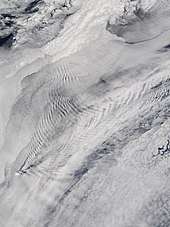
As of 2014, Marion Island, prefix ZS8, was the third most wanted DXCC "entity" by the amateur radio community. By the end of 2014, it had dropped to 27th, after simultaneous activity by three licencees in the 2013/2014 team. However, their activity was mainly on voice. On Morse telegraphy, the Islands remain the second most wanted entity after North Korea, while on data they are sixth out of 340.[43]
See also
- Crozet Islands
- Gough Island
- List of Antarctic islands north of 60° S
- List of sub-Antarctic islands
- Prince Edward Fracture Zone
- Protected areas of South Africa
- SA Agulhas
- SA Agulhas II
- SANAE
- South African National Antarctic Programme
- Vela incident
References
- "Prince Edward Islands". Ramsar Sites Information Service. Retrieved 25 April 2018.
- Cooper, John (June 2006). "Antarctica and Islands – Background Research Paper produced for the South Africa Environment Outlook report on behalf of the Department of Environmental Affairs and Tourism" (PDF). p. 6. Archived from the original (PDF) on 14 May 2016. Retrieved 5 October 2010.
- 1993 United Nations list of national parks and protected areas. World Conservation Monitoring Centre, International Union for Conservation of Nature and Natural Resources, Commission on Natural Parks and Protected Areas, United Nations Environment Programme. 1993. p. 173. ISBN 978-2-8317-0190-5.
- "Prince Edward Islands declared a Marine Protected Area". Department of Environmental Affairs, Republic of South Africa. 9 April 2013. Archived from the original on 12 July 2016.
- "Prince Edward Islands Marine Protected Area: A global treasure setting new conservation benchmarks" (PDF). Archived (PDF) from the original on 12 July 2016.
- Pieter Arend Leupe: De eilanden Dina en Maerseveen in den Zuider Atlantischen Oceaan; in: Verhandelingen en berigten betrekkelijk het zeewezen, de zeevaartkunde, de hydrographie, de koloniën en de daarmede in verband staande wetenschappen, Jg. 1868, Deel 28, Afd. 2, [No.] 9; Amsterdam 1868 (pp. 242–253); cf. Rubin, Jeff (2008). Antarctica. Lonely Planet. p. 233. ISBN 978-1-74104-549-9.
- "Marion Island, South Indian Ocean". Btinternet.com. 29 June 2003. Archived from the original on 29 July 2012. Retrieved 9 October 2012.
- "Marion and Prince Edward Islands". Retrieved 21 September 2016.
- Keller, Conrad (1901). "XXII – The Prince Edward Isles". Madagascar, Mauritius and the other East-African islands. S. Sonnenschein & Co. pp. 224–225. Retrieved 5 October 2010.
- Hough, Richard (1995). Captain James Cook: A Biography. W. W. Norton & Company. pp. 259–260. ISBN 978-0393315196.
- Mills, William J. (2003). Exploring Polar Frontiers: A Historical Encyclopedia, Volume 1. ABC-CLIO. p. 531. ISBN 978-1576074220. Retrieved 4 April 2014.
- "Marion Island – History". Sanap.ac.za. Archived from the original on 24 July 2017. Retrieved 9 October 2012.
- Ross (1847), pp. 45-47, vol.1.
- Cooper, John (2008). "Human history". In Chown, Steven L.; Froneman, Pierre William (eds.). The Prince Edward Islands: Land-sea Interactions in a Changing Ecosystem. Stellenbosch, South Africa: Sun Press. pp. 331–350, page 336. ISBN 978-1-920109-85-1.
- R.K. Headland, Historical Antarctic sealing industry, Scott Polar Research Institute (Cambridge University), 2018, p.167 ISBN 978-0-901021-26-7
- Wreck of the troopship Richard Dart
- "Four Weeks' Vigil of South Sea Crusoes". The Victoria Daily Times. 28 January 1909. p. 8. Retrieved 12 December 2019 – via Newspapers.com.

- "ALSA to talk on Marion Island's forgotten history at a SCAR conference". 24 August 2016. Retrieved 21 September 2016.
- Yeld, John (18 March 2011). "New Marion Island base opens". The Cape Argus (Independent Newspapers). Archived from the original on 25 April 2016.
- "New Base Puts Sa On Top Of The Weather". South African Garden Route. 21 March 2011. Archived from the original on 25 November 2015.
- "Google Maps". Google Maps. 1 January 1970. Retrieved 9 October 2012.
- Philip, L.; Abdurashidova, Z.; Chiang, H. C.; et al. (2018). "Probing Radio Intensity at high-Z from Marion: 2017 Instrument". Journal of Astronomical Instrumentation. 8: 1950004. arXiv:1806.09531. Bibcode:2019JAI.....850004P. doi:10.1142/S2251171719500041.
- "Marion Island". Global Volcanism Program. Retrieved 30 April 2015.
- "Marion Island". South African National Antarctic Program. Archived from the original on 24 June 2014. Retrieved 27 September 2016.
- Peakbagger – Van Zinderen Bakker Peak, South Africa
- General Survey of Climatology, V12 (2001), Elsevier
- GISS Climate data averages for 1978 to 2007, source – GHCN
- "Marion Island Climate Normals 1961–1990". National Oceanic and Atmospheric Administration. Retrieved 15 December 2012.
- "Station Ile Marion" (in French). Meteo Climat. Retrieved 11 June 2016.
- "Marion Island Marine Mammal Programme". Marionseals.com. Retrieved 28 April 2016.
- "Southern Indian Ocean Islands tundra". Terrestrial Ecoregions. World Wildlife Fund.
- "Marion Island Killer Whales". Marionkillerwhales.com. Retrieved 28 April 2016.
- M. Postma, M. Wege, M.N. Bester, D.S. van der Merwe (2011). "Inshore Occurrence of Southern Right Whales (Eubalaena australis) at Subantarctic Marion Island". African Zoology. 46: 188–193. doi:10.3377/004.046.0112. hdl:2263/16586. Retrieved 9 March 2016.CS1 maint: uses authors parameter (link)
- Berzin A.; Ivashchenko V.Y.; Clapham J.P.; Brownell L. R.Jr. (2008). "The Truth About Soviet Whaling: A Memoir" (PDF). DigitalCommons@University of Nebraska – Lincoln. Retrieved 9 March 2016.
- Bloomer J.P.; Bester M.N. (1992). "Control of feral cats on sub-Antarctic Marion Island, Indian Ocean". Biological Conservation. 60 (3): 211–219. doi:10.1016/0006-3207(92)91253-O. Retrieved 23 September 2016.
- John Yeld. "Marion Island's Plague of Mice". Retrieved 23 September 2016.
- K Berthier; M Langlais; P Auger; D Pontier (22 October 2000). "Dynamics of a feline virus with two transmission modes within exponentially growing host populations". BioInfoBank Library. Archived from the original on 10 February 2012.
- de Bruyn P.J.N. & Oosthuizen W.C., eds. (2017). Pain forms the Character: Doc Bester, Cat hunters & Sealers. Antarctic Legacy of South Africa. ISBN 978-0-620-74912-1.CS1 maint: extra text: authors list (link)
- "The killer mice of Gough Island". Financial Times. 27 May 2016. Retrieved 23 September 2016.
- "Ridding South Georgia of rats and reindeer". Retrieved 26 September 2016.
- "Impressions of an expert. Field work to assess the feasibility of eradicating Marion Island's mice completed". Retrieved 26 September 2016.
- Cooper, J. et al., "Earth, fire and water: applying novel techniques to eradicate the invasive plant, procumbent pearlwort Sagina procumbenss, on Gough Island, a World heritage Site in the South Atlantic", Invasive Species Specialist Group, 2010, Retrieved on 12 February 2014.
- "Club Log: DXCC Most-Wanted List for April 2016". Secure.clublog.org. 23 April 2016. Retrieved 28 April 2016.
Sources
- LeMasurier, W. E.; Thomson, J. W., eds. (1990). Volcanoes of the Antarctic Plate and Southern Oceans. American Geophysical Union. ISBN 978-0-87590-172-5.
- "Marion Island". Global Volcanism Program. Smithsonian Institution.
- "Prince Edward Island". Global Volcanism Program. Smithsonian Institution.
- Jenkins, Geoffrey (1979). Southtrap. William Collins, Sons and Co Ltd. ISBN 978-0-00-616116-5.
- Ross, James Clark (1847). . London: John Murray – via Wikisource.
- de Bruyn P.J.N.; Oosthuizen W.C., eds. (2017). "Pain forms the Character: Doc Bester, Cat hunters & Sealers". Antarctic Legacy of South Africa. ISBN 978-0-620-74912-1.
External links
| Wikisource has original text related to this article: |
- South African Research station on Marion Island – Official website
- Facebook Pages – Marion Island team publications
- Facebook Groups – Marion Island team discussions
- Marion Island seal and killer whale research – Official Marion Island Marine Mammal Programme website
- No Pathway Here – An account of the annexation of the islands
- Earth Observatory – Image of the Day 18 October 2009
